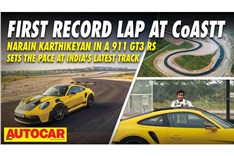Porsche 911 Turbo
Stiff competition from Nissan’s GT-R has ensured that Porsche’s recently updated 911 Turbo takes a big leap forward. Shapur Kotwal hangs on to the wheel.
Published on Dec 14, 2009 08:00:00 AM
4,472 Views
Follow us on
.jpg&w=700&c=1)
.jpg&w=700&c=1)
.jpg&w=700&c=1)
RAW DATA SELDOM makes for a good story. But in the case of the thoroughly updated 911 Turbo, it’s fair to make an exception. The reason: there’s just no better way to fully understand the jet fighter-like thrust this car generates as it is catapulted off the line using Formula 1-inspired launch control. The performance comes courtesy a new direct injection turbocharged flat six which is crucially mated to one of Porsche’s new twin-clutch gearboxes. Porsche Doppelkupplung or PDK, as the German car maker calls its gearbox, reduces shift times and prevents losses in momentum dramatically. The acceleration test data comes from the V-box satellite-based timing gear and is near-identical to that used by Autocar India for our test in India.
To use the launch control of the new 911 Turbo you need to select Sport Plus, squeeze the brake pedal down hard with your left foot and go to full throttle with your right. And by full throttle I mean full, right down till you can feel the ‘kickdown’ button below the accelerator. The words ‘Launch control’ now light up on the steering wheel. At the same time, the motor spinning at 5000rpm assumes an angry note, causing the rear of the car to squat like a big cat ready to pounce. Now all I need to do is make sure nothing’s in the way.
And when Porsche says launch, it means LAUNCH! As soon as you get off the brake, the system waits a fraction for turbo boost to build up to 0.5 bar and then it lets go the clutch, WHAAAP. The acceleration is not dissimilar to being let off a giant bowstring, the accelerative forces ramping up rapidly with a rubber-band-like effect that gets stronger and stronger.
Look at the acceleration table elsewhere in this article to fully comprehend the flight of the arrow, which in this case happens to be the new 911 Turbo in overboost (see ‘Turbo Tech’ panel) mode. Zero to 40kph comes up in a ridiculous 1.1 seconds. In two seconds and just 19 metres you are doing 70kph and 0-100kph is dispatched in a superbike-matching 3.2 seconds! If this doesn’t make your head spin, nothing will.
What’s even more impressive is the manner in which the 911 Turbo goes about making this speed a bit different from what you expect. It’s not seamless or smooth, the car shooting forward in a succession of tightly packed bursts of power. As the turbo motor dumps approximately 460bhp to the four wheels at 5000rpm, the launch control system allows only a foot and a half of wheelspin off the line from the super-wide 305mm rear tyres. The gearbox short-shifts to second gear a bit further to prevent more wheelspin and as the four-wheel-drive system hooks up the power in second, you are slammed back into your seat with a force of 1.1g, before the PDK gearbox executes another lightning-quick short-shift. By around 120kph, the car has enough grip to hook up all 500bhp and permanently pins you to the backrest of the seat.
All this happens in rapid fire succession as 0-150kph is dispatched in a scarcely believable six and something seconds! And 0-200 takes a simply absurd 10.9sec. To 160 it’s only a second slower than the fabled McLaren F1 road car and the new Turbo leaves cars like the Pagani Zonda C12 S in its wake. Superbike-matching pace from a car that weighs 1570kg — where are those bikers now
Longish bursts of acceleration on public roads, with buildings and barriers much closer to the car than on a track, are real eye-openers. Any slug of acceleration draws a sharp intake of breath; hold on to the accelerator a bit longer and you are soon in hyper-car territory.
Getting up to 250 or even 280kph on expressway-like toll roads takes only a few seconds of right foot down, and the incredible stability of the car just goads you into going quicker and quicker. Doing 200 feels like 120kph and the Turbo’s controls feel so precise you find yourself taking corners at 230 or 240 quite easily, with no sway or lateral movement from the car whatsoever. Real twilight zone stuff.
Even better is the fact that you can use a lot of this performance on the road. After timing the cars on the track, we were let loose for a day on Portugal’s best winding roads and highways. Naturally, we expect billiard-smooth tarmac en route; this car does have 500bhp after all. But Porsche’s pre-selected route initially serves up poorly surfaced roads full of rough patches and badly executed repair work, not dissimilar to those found here in India. However, despite the ultra-low profile tyres (35 front and 30 rear), the 19-inch rims and the stiff suspension set-up, the new Turbo feels quite comfortable over them. At first I slow down to a crawl in an effort to protect the rims. But it’s soon evident that the new 911 Turbo rides better than any serious sports car around.
In no time at all, I’m positively attacking corners on stretches of Portugal’s isolated and less-than-perfect roads, the 911 Turbo not upset by the constantly changing surface, even as speeds and cornering forces build. In fact, as we go faster, I find the new Turbo skimming over rough patches with the compliance of a rally car. Yes, bigger holes and dips do upset it and cause it to go thud, thud and that’s only to be expected. Still, the relatively friendly ride should work wonders for this car in Indian conditions. It’s several times better than the Nissan GT-R, which in contrast seems to have wooden blocks instead of springs and dampers. And you can thank Porsche’s adjustable dampers and active engine mounts (see ‘Turbo Tech’ panel) for this.
Of course using 100 percent of the power everywhere is simply impossible with a car that has this much performance. But the Porsche is stable and agile enough to allow you to give it a thorough workout on some stretches and sets of corners. And it’s here that this car makes your hair stand on end. Porsche’s Torque Vectoring system allows you to really brake hard going into a corner as it sets the car up perfectly for the corner with individual wheel braking. The paddle shift PDK ’box allows for crisp downshifts and with not that much weight over the front wheels, the steering is deliciously accurate. The Porsche darts into corners with the poise and perfect balance of a downhill skier and you know you can feed in power smoothly as soon as you begin to unwind steering lock. And let’s be honest, accelerating hard out of a corner, with the 911’s weight on the rear wheels and rear tyres really loaded is a real thrill few cars can match.
Nevertheless, with the engine slung behind the rear wheels, the fear of ‘exiting backwards through a hedge’ feels very real. However the harder you drive this four-wheel-drive car, the more confidence the new set-up inspires. It just seems to welcome you into using all its performance and the fundamental dynamic balance is so good that it feels it has the weight distribution of a mid-engined car. Which, of course, it isn’t.
Of course on the road, there’s just no using the ‘Sport Plus’ or even the ‘Sport’ button, unless the road is billiard-table flat. Even at 250kph, you need the extra suppleness of the suspension to flatten out the bumps and that means the car must be driven in its normal street setting. Let the Turbo loose on a track though and Sport Plus is the only way to go as the Porsche goes to a sportier set-up for both performance and handling. Porsche got us to do just that on the Estoril F1 circuit on two of the three days of the drive, and it’s only here that we could ramp up our speed enough to get a glimpse at the car’s on-limit handling and simply massive performance envelope. Sport Plus allows you much more leeway with the ESP (PSM in Porsche-speak) and that of course means that little bit of extra 911 rear end slip manifests itself when you are really up to track speeds. But even then it’s friendly and progressive if you are smooth.
The only real issue I have with the new Turbo is when it is driven in traffic. In the search for greater fuel economy and lower CO2 emissions, the gearbox rapidly shifts up the gears when it’s driven in ‘D’, leaving you to deal with the turbo lag present below 2000rpm. Also, higher-profile tyres would be safer in Indian conditions as would more ground clearance. But even as it stands, this would make it the most useable hypercar in our conditions. Massive performance, incisive handling, a big safety net and half-decent ride too. Though expensive, the Turbo has always been a halo car for Porsche, and this one with a little nudge from the Nissan GT-R has turned out to be probably be the best one ever.
Tech Specs 
Copyright (c) Autocar India. All rights reserved.







 Price
Price Engine
Engine Body
Body Dimensions
Dimensions
Comments
Member Login
Personal Details
No comments yet. Be the first to comment.